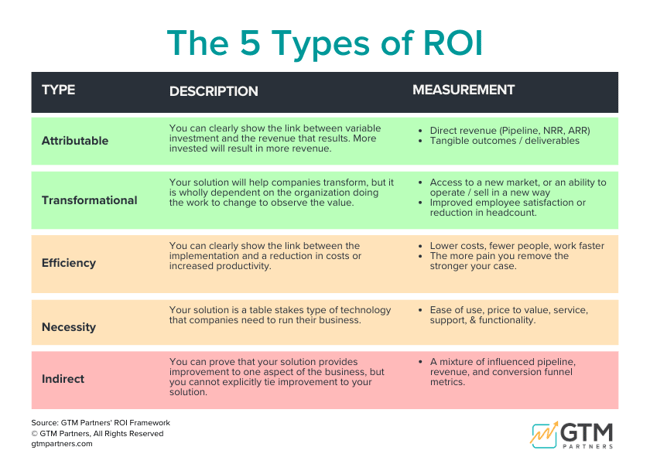May 17, 2023
 by Sangram Vajre / May 17, 2023
by Sangram Vajre / May 17, 2023

Not redefining ROI yet? There's still time to adopt a new understanding of ROI that can influence 2023 sales.
At least once a week, a revenue leader at a B2B company tells us some version of one of the following statements:
“Our sales are getting blocked by the CFO/CEO because we can’t show ROI.”
“Our pipeline is stalled, and we can’t move it forward.”
“Retention is terrible because we can’t prove value at renewal.”
“Deals we thought were sure things aren’t coming through, or they’re taking forever."
According to our research, 60% of companies struggle to show ROI. That struggle is the number one reason why pipelines aren't closing, renewing, or expanding. Business leaders are stuck with outdated, limited, and confining definitions of ROI that may not fit their business model. And without ROI, your decks, demos, and dinners are no longer enough to convince CFOs and CEOs to pull the trigger in a slow economy.

Source: GTM Partners
The good news: there's still time to expand our understanding and execution of ROI before the end of the year. Companies that can demonstrate ROI will have a higher chance of closing deals and retaining customers.
When most people talk about ROI, the most common definition is net income divided by the total cost of the investment times 100. If you spend $10,000 on something and it generates $123,000 in net new revenue, the ROI is 123%.
“This narrow definition of ROI is limiting for companies that are either one part of a complex solution or struggling to show directly attributable ROI.”
Sangram Vajre
Co-founder and CEO of GTM Partners
Does it mean that your solution doesn’t have value if you can’t unequivocally prove you’re making more than you cost?
Here’s one example: a major retailer pays three vendors as part of an effort to improve their e-commerce site. One is a customer satisfaction (CSAT) measurement vendor for $50k, one is a UX auditor for $30k, and one is a customer journey consultant for $75k.
All three identify and prioritize the cart abandonment process. Changes to the customer experience made by the internal development team result in $6.2 million in net new sales the quarter after relaunch.
All three vendors and the internal team want credit for the new revenue, but it’s impossible to isolate the influence of any one piece. Being unable to calculate directly attributable ROI doesn’t mean they weren’t all valuable.
What about a company that is completely transforming the way its customers do business, but can’t prove it unless the entire company goes through an effective change management cycle?
In order to answer those CEO and CFO objections stalling your pipeline, you need to be crystal clear about what kind of ROI you provide to your customer. These conversations should take place with a cross-section of functional leaders involved. Next, you need to collect the necessary data and evidence to prove that ROI exists.

Source: GTM Partners
GTM Partners has identified five clear types of ROI. Attributable ROI is the kind we usually think about when we discuss ROI, but in fact, each one of them can be leveraged to close deals, increase renewals, and improve expansion.
Each of these five types of ROI can be leveraged to win deals, but there are some nuances to keep in mind.

Source: GTM Partners
Companies that can show Attributable and Transformative ROI are at an almost insurmountable advantage. They’re not going to get cut at renewal time even when budgets do because either they’re transforming how customers do business or they can prove directly attributable ROI. Companies in the winning zone can out-maneuver competitors through big strategic moves and investments.
Vendors in the Efficiency and Necessity ROI zones can be very successful and may even be the category leader. However, they’re constantly battling the competition and defending against other players and newcomers who can easily force competition on features, ease of use, price, and efficiency gains. It’s important to remember companies in this zone can and do win – they just have to be prepared to battle.
Vendors who can only show Indirect ROI are in what we call the muddy middle, where retention gets hammered. In a down economy, CFOs will not approve new or renewed tech that can’t show ROI. Companies showing Indirect ROI get lumped with dozens of other providers as one of many contributors to some final outcome.
Your goal is to move up the slope on whichever side makes sense. If you’re in Indirect ROI, you need to be able to move up to either Efficiency or Necessity. If you’re already at Efficiency, how can you move up to Attributable? If you’re at Necessity, how can you move up to Transformational?
Our research shows that credible, validated, third-party ROI studies can address many common sales problems. We do ROI studies here at GTM Partners using proprietary research and validated G2 data, but you can also get an ROI study from other analysts.
We don’t care who you get it from, but make it a short-term priority if you want to influence deals this year. It will help you shorten sales cycles, close bigger deals, get the CFO on board, improve renewals, and increase expansion deals.
Once you have your ROI study, be sure to leverage it throughout the entire customer journey.
Perhaps the most common use of an ROI study, many companies show their proof of ROI during the sales cycle to prospective buyers. When you have credible, third-party-validated ROI, it can shorten sales cycles and address common objections. Don’t forget to go beyond traditional case studies. Bake your ROI data into demos, testimonial videos, sales decks, and webinars.
Be sure to share ROI from similar customers during onboarding. In doing so, you’re telling your customer what kinds of things to look for and preparing them to experience the same kind of success.
Consider sharing ROI case studies during quarterly business reviews or other strategic check-in points. You may be giving your customers ideas for use cases they aren’t taking advantage of yet, and you may be priming the pump for them to consider their own ROI in the future in ways that will help at renewal.
Hopefully, by renewal time, your amazing value and all your relevant use cases are very familiar to the customer. Hopefully, they’ve evaluated their own ROI with your product and are satisfied. But not every customer will have access to business-level data that allows an ROI calculation, so renewal can be a good time to remind them of your proven value to customers in a similar boat.
G2 and GTM Partners are teaming up to create ROI deliverables just for G2 customers. If you are a G2 customer and have at least 50 reviews on G2, GTM Partners’ analysts can create a third-party, analyst-validated perspective showcasing your ROI that you can share with prospects and customers along the customer journey.
After all, your customers are your best salespeople, and G2 provides a window into your customers’ voices that allow us to produce ROI studies at scale and at a reasonable cost.
Here’s an example we did with Sendoso. Sendoso is using the ROI case study to show value and accelerate deals through the pipeline.

Source: GTM Partners
ROI is more than just money saved or money made. Being able to clearly communicate your ROI to customers and prospects will transform your GTM strategy. You will almost instantly improve your win rates, boost NRR, and shorten sales cycles.
If you are a G2 customer with at least 50 customer reviews, contact your G2 sales rep to learn more about ROI-in-a-Box from GTM Partners. If you aren't, but want to learn more about GTM Partners’ other ROI offerings, book a free 30-minute strategy session.
Sangram Vajre is co-founder and CEO of GTM Partners, a data-driven analyst firm that helps B2B companies achieve efficient growth. He’s also the author of three books on go-to-market strategy, including the Wall Street Journal bestseller, MOVE: the 4 Question Go-to Market Framework. Before founding GTM Partners, Sangram co-founded Terminus, which earned a spot in Deloitte's fastest-growing company list after hitting $15M in three years. He also ran marketing at Pardot (acquired by ExactTarget and then Salesforce). Sangram, his wife, and their two children live in Alpharetta, Georgia.
Can you sell AI products without mentioning AI?
 by Sidharth Yadav
by Sidharth Yadav
Ask any startup founder if you have a go-to-market (GTM) problem. It's entirely possible that...
 by Shashwat Ghosh
by Shashwat Ghosh
Did you know that tracking career transitions could help you sell more?
 by Sidharth Yadav
by Sidharth Yadav
Can you sell AI products without mentioning AI?
 by Sidharth Yadav
by Sidharth Yadav
Ask any startup founder if you have a go-to-market (GTM) problem. It's entirely possible that...
 by Shashwat Ghosh
by Shashwat Ghosh


